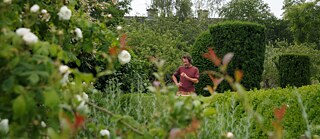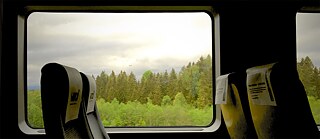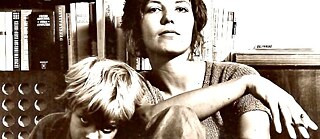Everyday Expeditions
The Garden
Jakob Lewis and his wife Catherine transformed their front yard in Nashville into a garden. From conception to harvest, Jakob meditates on the lessons he learned about imagination, play, and grief, all the while drawing on the wisdom of Goethe.
Listen to this episode: Apple Music | Spotify | Download
This story comes from Jakob Lewis. Jakob is the creative director of Great Feeling Studios in Nashville, Tennessee. He was born in Germany while his father was stationed there with the military. Although he left Germany as a baby, his interest in the country has remained strong. In this episode, Jakob welcomes listeners into his front yard where his wife has planted a garden. The music in this episode is from Blue Dot Sessions, and the featured photo is from Yassine El Mansouri. For more on the Lewis family, listen to Jakob’s other pieces: “My Pen Pal,” “Finding My Parents,” and “What’s a Sister City Really?” “My Pen Pal” is also available in German. Yassine El Mansouri provided the photo for this piece.
Transcript
Jakob Lewis: The Garden. Introduction.
Catherine Lewis: … kind of turned into what if our whole front lawn was a garden. I guess I don’t have a certain point of when it all started, but it was just a vision that grew out of sitting and looking, I guess.
Jakob Lewis: Important things can happen from sitting and looking, especially attention paid over time, focusing on something and revisiting it again and again, through different seasons, and slowly ... a leaf unfolds in spring. The possibility of which was always there. In my front yard is a garden. It was my wife, Catherine’s idea. It wasn’t here at the beginning of the year. Now in December, it’s here. There’s a massive 25-foot circle maze of mulch. A field of wheat, herbs, and perennials and vegetable plots that lie fallow.
As I stare at them through a large picture window watching the gray sky spit down snow, I remember the purple carrots that we roasted for Thanksgiving. The five marble-sized potatoes I got as my potato harvest because I planted them too late. Now those beds sleep, getting ready for next season. The garlic is the only visible sign of what’s really going on.
I watch as their tassels swish from the wind and their neat rows, as I drink my tea in the morning, it’s going dormant. The great mystery of this existence of ours that life somehow comes from death. Next year, sauteed in olive oil, garlic will fill our kitchen, feed our bellies.
Our son smacks the glass as he looks at the birds at the feeder, just outside the ring of the garden.
Oscar Lewis: [BABBLE]
Jakob Lewis: It’s my recorder. Can you say microphone? Can you say ‘mic’?
Catherine Lewis: He’s like, "No."
Jakob Lewis: Our family has a small white brick cottage home in a mostly quiet neighborhood in South Nashville in Tennessee. It’s me, Jakob, my wife, Catherine, and our one-and-a-half-year-old son, Oscar. We have one dog, Bagheera. He’s black with a large, almost pit bull-like head and dainty hips. His older brother Hobbes was an orangy brown dog. Brindled with black stripes. He rests in a grave in the backyard. My wife planted some lamb’s ear on top of him. It’s now shriveled in the cold frost. It’s here now in the winter, as the earth goes to sleep, that we have time to imagine what once was and what could be. Again.
Jakob Lewis: “As soon as you trust yourself, you will know how to live.” – Goethe. Chapter one: Imagination.
Catherine Lewis: I would say back in March, right when everything started shutting down, I kind of leaned more into gardening, got more like prepared in the garden that I had I’ve had for a few years and like really weeded it. And then started like paying attention to it and way more than I usually do. And got excited about plants in that kind of smaller space on the side of the house.
Jakob Lewis: Catherine would come in from spending time in the garden with Oscar to feed him lunch. In his high chair with his face covered in beans or spaghetti sauce, Catherine would stare out the window at our front yard. In our existing flower beds, she would see Celosia that brought butterflies and hummingbirds. Lantana that brought in loads of bees. We’d get rabbits, squirrels, and if you walked through our yard, you’d feel a sinking sensation where the moles have tunneled. Underneath the soil is an ecosystem of worms, bugs, and bacteria. These are some of the inhabitants of our shared space that she would note, but the most obvious as she stared out the window, would be next to a maple tree I planted just before Oscar was born.
Catherine Lewis: It’s been a big joy to just look out our window and look at the bird feeder, you know, sparrows and wrens, finches, cardinals. I have seen some crows though. Some woodpeckers. We have a Downy woodpecker. Juncos. They’re very cute. Chickadees also. That’s another one we have a lot of. Blue Jays. Red bellied, woodpeckers. Yeah. Tufted Tit Mice … We’ve been getting a lot of Bluebirds lately. It’s kind of delightful.
So I think just like paying more attention to plants and looking outside more, the more I stared at it, the more I started to see ... what if, what if I extended that garden and made it a little bigger? Or what if we just took that whole section by the sidewalk and turned it into a garden? Or what if we stretched, stretched it out all the way to the mailbox. It’s like, my vision kept getting bigger and bigger. The, the more I stared at the space then, kind of turned into what if our whole front lawn was a garden.
Jakob Lewis: An intellectual I love, Dr. Willie James Jennings, says that imagination is the womb in which reality comes into being. So we better cultivate a good imagination because a twisted one can birth a horrible destructive reality into the world. A virtuous imagination can create beautiful possibilities. At some point fantasy is acted upon.
Catherine Lewis: In my moments where I’m kind of down about the current situation, I start to fantasize about going somewhere else or like buying, buying some land somewhere, but I’ve with this garden, I’ve kind of felt like, you know, maybe one day we’ll do something like that, but it’s not like you don’t have land right now. We do, we have a significant yard, both in the front and the back and if what I want is to cultivate land and grow things, then I really should just lean into the space I do have.
[OSCAR RUNNING AND PLAYING]
Catherine Lewis: It was always in my mind. Something sort of circular, but I think there are a few iterations of what that exactly would look like.
Jakob Lewis: She wanted a circle labyrinth, a meditative monastic ramble to meander through peacefully in our yard, not in our backyard, hidden and under a lot of shade, but in our front yard, in the full sun, exposed to the community.
Catherine Lewis: And then we just started to dig.
Jakob Lewis: Can you tell me about that process?
Catherine Lewis: Yeah. So, uh, we, we also had a bit of back and forth ...
Jakob Lewis: “By seeking and blundering, we learn.” – Goethe. Chapter two. Chip drop.
ChipDrop Commercial: As we all know, arborists wood chips are the best mulch for your garden. So if you don’t want to have to flag down your local arborist ChipDrop is the second best way to get that mulch for free.
Here’s how it works. [FADES UNDER]
Jakob Lewis: This is a video on ChipDrop’s website. It’s a free service that connects folks who want mulch with arborists, who just chopped down trees. They have to pay to dump it somewhere unless people like us want it.
[SOUND OF CHIPDROP TRUCK]
A giant truck dumps a steaming heap of wood chips, right in our driveway.
Catherine Lewis: Oh my God.
Jakob Lewis: It’s enough for about five, maybe six of our sized gardens.
Catherine Lewis: They came at a good time. That part of the thing with ChipDrop is you don’t know when it’s coming and you don’t know how big the load will be. Um, but it came at good timing. Cause it was kinda right when we were starting to get like the cardboard, our first like pile of cardboard came. So we could, you know, put cardboard down in the section and then just go ahead and throw a bunch of mulch on top. And from there it went pretty fast.
Jakob Lewis: Cardboard, mulch, cardboard, mulch, Oscar would pick up a stick and act like it was a shovel. He got to ride in the wheelbarrow a bunch that week. When you’re making a new garden bed on a lawn, you can dig the grass out, which is a lot of work. Or smother it to death with cardboard and mulch. Much easier.
Catherine Lewis: Um, you want to walk around and look at it. Okay. Over here, we’ve got some cabbage that is mostly dead. Um, but I’ve got one, one guy hanging on. That’s kind of coming back to life. I sowed some more seeds too. And it looks like a couple of seedlings popped up, but I don’t know. They just, they’re like growing and then dying. Um, and then we’ve got two rows of garlic that are doing, they look real happy.
Um, I think this, I had some broccoli that was already kind of on the brink, but it was surviving, but then we got a freeze the other night and I think that kind of took it. But these seedlings right here, um, I planted some artichokes, and I’m hoping that’s what that is because that’s what I planted there. Although they kind of look like the beginnings of some squashes. I don’t know. I never planted artichokes before. I don’t know what it looks like.
Over here is a bunch of dead butternut squashes … There’s one that I think is probably actually a pumpkin, um, that I transplanted right before the freeze. It looks like it’s, um, holding on.
And we’ve also got some … Oscar is walking through daddy’s wheat field on the edge outside of the circle is planted a lot of wheat, and it is just a glorious green field right now.
Jakob Lewis: I wanted to make some bread.
Catherine Lewis: It looks so lush. Umm umm, umm. Okay. Last two beds on the outside. We’ve got carrots here. Lots of carrots.
Jakob Lewis: Little happy carrots.
Catherine Lewis: Yeah, lots of happy carrots. There’s nothing here, but there was potatoes. Um, you just harvested …
Jakob Lewis: Oscar, don’t step on those. You just stepped on daddy’s carrots. Daddy’s prize carrots.
Catherine Lewis: Now. When we’re out here, we have to be a little more, he can’t just like walk around as much … use gentle hands. You can go pick those flowers over there, there’s, lots of different types of greens, three different types of spinach and a different type of cabbage.
That’s like, it’s just like kale again. It’s all an experiment.
Jakob Lewis: It really is. Most of the middle of the garden is made up of the perennials. Many of these Catherine just found on a walk by a creek or in a ditch. She would take some roots and all or make a cutting and see if it would root in a jar of water on a window sill.
After most of the stuff was planted, we still had a giant pile of mulch taking up most of our driveway. And how do you get rid of a giant pile of mulch? Find out next time on The Garden!
“Behavior is the mirror in which everyone shows their image.” – Goethe. Chapter three, play connects us all.
Catherine Lewis: Do you want to make a road for your truck with these pieces of bark?
Jakob Lewis: Can you say ‘mic?’ [BABBLE] Yeah, it’s a mic. Don’t touch that part. That’s where all the buttons are, but touch the butt.
Catherine Lewis: Look, honey, your truck can ride on these pieces of bark.
Jakob Lewis: If you split our garden circle into quadrants, three quadrants have plants. One doesn’t it’s an outdoor play area for Oscar.
Catherine Lewis: Got a bucket on a string.
Jakob Lewis: The old bucket on a string.
Catherine Lewis: Yeah. So we, um, anyway, he can kind of climb on the different stumps and stuff, and there’s this really cool, um, branch that fell that has like three, um, it’s really hard to just describe something, isn’t it?
Jakob Lewis: It’s what I do for a living.
Catherine Lewis: I know for people who can’t see it, words are hard. Um, I guess it’s like a branch tripod shape.
Jakob Lewis: I’ll just, I’ll just narrate this part and describe what it looks like.
Catherine Lewis: You told me to say what we were looking at anyway.
Jakob Lewis: She’s right. And I’m a jerk. It’s a tripod made up of a branch from a tree that had three smaller branches coming out of it. You cut it at the right place. And you’ve got what looks like a little fort or tent, or like a spindly alien. This is here because of play, curiosity, and wonder. Earlier this year I was lying in a hammock in the middle of the day, staring up at the trees swaying above me in our backyard. We love our backyard neighbors, Walsh, Arielle, and their two boys, Eli and Isaac.
In fact, in the middle of the year, we installed a gate in the chain link fence so we could pass freely between our houses. They have a coop with a dozen chickens, a deck fort area designed by one of their fathers who was a landscape architect. They have bees set on a hillside. These are their new bees, their old ones were really aggressive, so aggressive that when they had them swapped out with new bees, the guys who did it said those were the meanest bees he’d ever seen.
As I was staring up in the hammock, watching the tree sway, there’s one that grows from their backyard that hangs over ours. I texted the ever mild-mannered Walsh, owner of said property, suggesting that we cut it together. About a week later, we got a pole saw and took it down. Bit by bit. Then he brought over his chainsaw and pared it down even further.
It’s always good to know someone who has a chainsaw. Walsh has a bunch of these tripod sections of branches that he uses for trellises in his garden. I realized we had an opportunity to have one too. So we cut it up and, bing, bang, boom, it made its way into the section we call Oscar’s garden.
Catherine Lewis: Anyway, I tied a bucket to a string and put it in the middle of it. And it’s sort of like a little fort, um, and he can like pick up his bucket and stuff. So that’s this area, uh, which is pretty fun.
Jakob Lewis: It is fun. As a father with a boy who can now run and jump and point at dogs passing and say, ‘doggy!’ I’ve remembered just how fun it can be to go outside and just pick up some sticks and throw them. I’m always enamored with the tiny things that he finds. The bucket that Catherine mentioned is red. Oscar will take it on a walk and start collecting things. When we get back to home base, there’s a bucket full of wet leaves, sticks, gravel, soda-can tabs. The way Oscar plays, he takes it quite seriously.
Yeah. He’s giggling and jumping in puddles, but he’s intent and focused. That kind of play is like a light, continually drawing people close to want to see it, to want to be part of it. Shortly after the garden was first established, Catherine found an old wooden plaque at a store, the kind of store where donated items are given a second chance to be reused.
She used white paint to squiggle out a cute little sign for the garden. It was a playful thing to do. It said ‘Live Oak Community Garden.’ Live Oak is the name of our road. Neither of us knew the specifics of what a community garden would take, but we knew that we wanted to invite others in. She just painted it and stuck it out front. That posture of openness to the world, openness to play, seems to have a good track record of producing some fruit in our lives.
Catherine Lewis: Most of October, I had it, uh, kind of decorated for Halloween. I created this tunnel and with spiderwebs and stuff so that when people came to trick or treat and they got their candy at a distance, [OSCAR BABBLE] they had something kind of fun to do. Crawl through the tunnel and get your treats.
Robyn Burns: You got this dude! Get down on your knees.
Jakob Lewis: This is our nephew who lives about five minutes away, dressed up like Mario wearing a Mario Cart around him, like he’s driving it. He’s climbing through a spiderweb tunnel through this tripod thing in Oscar’s section of the garden,
Robyn Burns: This is awesome! Look at all these.
Catherine Lewis: Those ones don’t have any peanuts.
Jakob Lewis: Catherine organized a safe Halloween for our historically low-trafficked street. We had the most Halloween spirit on the street we’d had in the 10 years we’ve lived here. People with individual bags set at the end of their driveway, scary graveyards in their front lawns, cute little ghosts hanging from their trees.
We had a pumpkin-carving contest. They were all displayed in front of another neighbor’s house. I gave the winner a loaf of honey sweet potato bread. They carved a sloth. Doing things just because ... playing … it’s strangely fruitful. It feels inefficient yet, yields a deeply impactful harvest. Community often comes about. And in this instance, that giant pile of mulch in my driveway. Well, our neighbor Walsh ended up taking the rest for his garden. He left our driveway spotless. Thanks, Walsh.
“Life belongs to the living and he who lives must be prepared for change.” – Goethe. Chapter four: Grief or Annuals and Perennials.
At the beginning of the pandemic, I got a really meaningful, albeit unfortunate opportunity. One of the first COVID casualties in Nashville was songwriting legend, John Prine. When he passed, my local public radio station asked me to help produce a radio wake in lieu of actually gathering to honor John. They collected stories from his personal and professional life. Fans called in and it was beautiful.
I think it served a much bigger purpose for the community at a moment where we all didn’t know what was coming or so much felt deferred for some indeterminate date, we needed to lament. To cry. To honor our losses. Cultures around the world have rituals to guide us through the common passages of this life. We have weddings, funerals, graduations, and bat mitzvahs. We don’t have anything for this. So even though we honored John, it felt like we were honoring all of our losses. I poured a glass of bourbon and listened to the hour-long show. The online streaming crashed because so many people around the country were tuning in.
Turns out, we have a need to lament. Earlier, when I played the clip of the truck, delivering mulch for our garden, if I extended it a little more at the beginning, you would have heard this [DOG BARKING]. That’s our dog Hobbes barking. When we planted this garden, we had two dogs. Catherine and I got Hobbes ten years ago from an animal shelter. He was already probably between five and seven years old. He had brindled stripes and an orange-ish tint. We named him Hobbes like the tiger from Calvin and Hobbes. We were in our early twenties, borrowed some DVDs of the dog whisperer from a friend.
I would be in our backyard, training him to sit, stay, and walk well on a leash. Ten years later, he slept all day and was covered in fatty tumors. His back legs were collapsing a lot around corners or getting up and down from places. He was really sweet, with our son, Oscar letting him pretty much do anything to him.
We started having the conversation about putting him down in July. It was in November when we made the appointment. The morning of, Catherine and I dug a hole in the corner, our backyard.
We held Hobbes, as he lied on the ground, the vet brought in Cheese Whiz. He went out eating Cheese Whiz. I couldn’t think of anything more perfect. When they gave him the injection, I wept. My wife wept. His body just stopped. I kept thinking, where is he? The vet took out some ink and made paw prints for us to have. They wrapped his body in a blanket and put him in the back of our Honda Element.
When we got home, we placed him in a wheelbarrow and wheeled him delicately to the backyard. His body was curled up on his bed. We lowered it down into the hole. I kept wanting to touch him. So I did. Just put my hands on him.
I recently heard a quote from author Jamie Anderson. It’s one of those internet quotes in which I have no idea the context of, or who Jamie Anderson is. So hopefully this isn’t stupid. But it says this: “Grief, I’ve learned, is really just love. It’s all the love you want to give, but cannot. All that unspent love gathers up in the corners of your eyes, the lump in your throat. And in that hollow part of your chest. Grief is just love with no place to go.
We covered Hobbes body with dirt. That stuff that we’re all made of. And we’ll all return to. The stuff that grows gardens. We placed a stone on top, a bouquet of flowers from the front. Then we read a liturgy for the death of a pet.
As grief overtook us, I got to really shake sadness’s hand. It had been a while. This year and in difficult traumas of the past, I’ve gone into survival mode, putting my head down and doing whatever it took to keep going. But that can’t, and shouldn’t, last forever. Turns out my heart has been like a river clogged with debris and putting my dog in the ground got it flowing again. And there was a lot behind that dam.
Annuals only come back through seed. When they die, what comes back is not the same plant, but something new. Perennials, if established, will go dormant and come back next year, it’s the same plant. But during drastic conditions, some perennials will remain dormant for a whole year. You might think it’s dead, but it’s just doing some mysterious work within itself below the surface.
Hobbes is not coming back. Many of us have only the hope of the annual. Sure, there will be other beautiful flowers down the road, but not the same flower I knew and loved, not the one who ate Cheese Whiz.
The lucky ones of us, that by some strange chance are still rooted, can pray that this year is like a perennial that was able to survive using drastic means. It’s in that stillness that we can keep watch for the spring and imagine our new gardens into possibility. Important things can happen from sitting and looking, especially attention paid over time, focusing on something and revisiting it again and again, through different seasons – and slowly the leaf unfolds in spring.
The possibility of which was always there.
Catherine Lewis: I appreciate having, now, multiple opportunities in various different gardens around our house now to experiment and kind of have a open-handed attitude towards life, having, having a hope for what I, I want to happen, but also holding it loosely and approaching it with curiosity and wonder … and hope.







